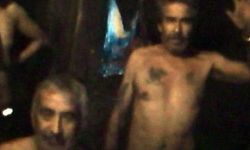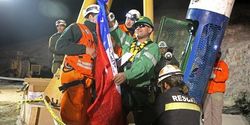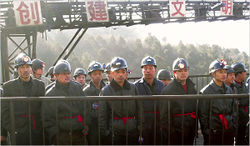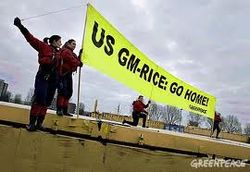User:Ptok-Bentoniczny/33 miners were buried underground
“In Polish mines you dig coal, in Australian ones you dig aluminium ore and in Chilean ones you dig miners.”
– Wikipedia on mines
An unusual mine accident took place on August 2010. As a result of the catastrophe, 33 miners were buried underground. However, it was nothing unusual in the reason of the disaster but it was uncommon that all of the 33 buried man survived despite they remained underground for 69/70 days.
Miners were lucky only because they were Chilean. There is no other country in the world in which they could've been rescued. Chile is the only country that respects the elementary right to life of all of their citizens. Moreover, Chilean president always looks for a good occasion to build his PR and is able to waste millions of dollars for saving life of several insignificant people.
In this article we'd like to show a possible course of action of rescuing 33 miners in chosen countries.
Location[edit | edit source]
Countries[edit | edit source]
Alderaan[edit | edit source]
Alderaan was blowned up by the Death Star. Now move out of your parent's basement and get a job. Oh yeah...find out what these things called girls are.
Armenia[edit | edit source]
An Armenian living in the USA calls Radio Erevan and asks if the accident in the biggest Armenian mine really took place and 33 of his compatriots were buried underground. Radio Erevan confirms but points out that they were not Armenians but rather Azeris, it was not an accident but rather a terrorist attack and it didn't take place in Armenia but rather in Azerbaijan.
Belarus[edit | edit source]
The Belarusian president - Alexander Lukashenko announces that the Poles should be blamed for causing the catastrophe. As a result he orders to arrest several dozens of Poles. Poland and Russia offers their help in rescuing the miners but Lukashenko refuses stating that Belarus got enough money to afford the action itself. All the miners die but Lukashenko saves his honor of a dictator that doesn't need any help.
Belgium[edit | edit source]
There are two independent rescue teams - Walloon and Flemish. Both team continuously fill up the tunnels of each other. As a result, the debate over the purpose of Belgium existence and possible ways of secession bursts out. In the face of the debate, lives of the miners become the filler in the TV news. However, all the miners die because Walloons and Flemish could not cooperate in the action.
China PR[edit | edit source]
China's government gets news about a catastrophe and announces in public TV that a rescue action pushes forward. In the meanwhile, they find another 33 miners and they order them to tell in interviews with international journalists that they were saved by the Party. After good news spread, government orders to kill all the other 33 miners so they can't tell anyone the truth. As a result, 66 miners die.
European Union (1)[edit | edit source]
The rescue action is postponed because the mine owner needs to file a petition for a permission for additional boreholes. In a meanwhile, mine owner is fined for "a baseless prolongation of working period". After several months the mine owner gets a reply that there was a mistake in a sent file and he needs to correct it in order to get the permission. In a meanwhile, the fine for "a baseless prolongation of working period" reaches an astronomical amount and the mine goes bankrupt. After several years of a trial the mine owner is sentenced for life for "not undertaking the rescue mission and purposeful killing of 33 people".
European Union (2)[edit | edit source]
The rescue action is undertook without any permission. After few days a clerk sent from EU iarrives at the site, who orders to fill up an already digged tunnel. In a meanwhile, European Council agrees on passing more strict mine security regulations. Two years later a regulation is passed. The regulation orders all mines to allocate 65% of their total income on security of miners. As a result, all the private mines in EU go bankrupt and all the national ones make big losses. That dramatically increases unemployment rate and slows down development of all EU countries.
France[edit | edit source]
An intensive rescue action begins as soon as there is an information about a disaster. Two days later all the rescuers hold up their work and go on strike. They announce they won't get back to work unless they get a 20% rise and a possibility of early retirement with normal pension. Governement opens negotiations and both sides sign an agreement after 25 days. In a meanwhile, press makes public the fact that all the buried miners are actually immigrants from Africa. Massive riots begin. Hundreds of cars are burnt and dozens of people die in shootings. The police arrests dozens of most aggresive immigrants, several thousands are deported. EU promulgates a resolution blaming France for their actions. After order is restored and rescuers get their rise, attention of everybody is back at the rescue action. Miner's shelter is reached 20 days later but all the miners are found dead due to lack of availble food.
Greece[edit | edit source]
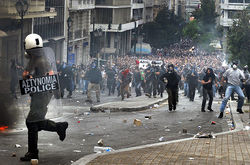
A mining accident is caused by a blunders in a methane control systems. However, no miner is buried because all of them were rioting in Athens against new reforms at the time.
India[edit | edit source]
As a rescue mission would be too expensive, the mine owner decides not to rescue the buried miners. Instead, he employs buried miners' relatives and pays them extra money for remaining silent. The accident is hushed up and nobody notices 33 missing people as there is no citizen evidence in India.
Indonesia[edit | edit source]
Other miners try to unbury their fellow employees until they reach the maximum depth reachable with shovels and picks. After a short prayer, the mine returns to its normal work. The buried miners' relatives are informed about their death by neighbors.
Italy (1)[edit | edit source]
The rescuers dig a thin tunnel to the buried miners. The miners get an information that the mine is said to be closed due to security reasons. As a result, the miners refuse to get to the surface. Moreover, they refuse to eat any food given to them by the rescuers. The streets in all Italian cities are flooded with angry people protesting against the government's antisocial policy. The government promises not to close the mine but then the miners demand rises. However, the mine owner does not agree on that. In effect, the miners die from starvation.
Italy (2)[edit | edit source]
The rescue mission is sent as soon as possible. However, the rescuers state that they are underpaid and therefore they start a go-slow strike also known as an Italian strike. They dig the tunnel to the miners in such a slow manner that all the miners die before the rescuers reach half the way down.
Japan[edit | edit source]
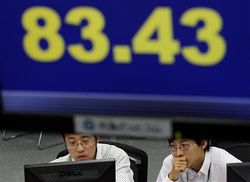
Just after the disaster, the Japanese turns off the "Mine Tycoon" computer game and starts playing another game.
Korea DPR (1)[edit | edit source]
Kim Jong-il knows that the accident was caused by the Southern regime and decides to dispose more soldiers at the border with South Korea. Seoul is deeply concerned about the situation and pays a bigger forced tribute that usual in order to calm the dangerous neighbor. Kim spends the money on his army and luxurious products for himself. Everybody forgets about miners and to ensure that, all the families of dead miners are killed and their neighbors are sent to work camps for next 10 years.
Korea DPR (2)[edit | edit source]
Kim Jong-il knows that the accident was cause by the miners that didn't take his teachings to their hearts. He decides to punish all the miners and suspends any rescue actions. Seeing that miners' attitude wasn't ideal, he decides to kill his families and sent their neighbors to camp works for 10 years.
Pakistan[edit | edit source]
Mollahs blame Christians for causing the catastrophe. As a result, nobody cares about rescuing the miners. Instead, everyone focuses on mass murders on Christians and setting fire to churches. Shortly after that, mass murders on Christians burst out in other Muslim countries. Situation gets back to normal after several weeks.
Poland (1)[edit | edit source]
An intensive rescue action begin. Five days later a financing of the action is put under control by NIK (Supreme Chamber of Control). As a result, the rescue action is suspended, all the miners die and the Polish president announces a week of national mourning.
Poland (2)[edit | edit source]
During the rescue action, the buried miners start a labour union and refuse to come out of their shelter. They demand rises and liftime employment guarantee. All the Polish nurses, railwaymen, rescuers and teachers spontaneously join their strike. The Polish Prime Minister is the first man that arrives at the site of the accident. He expresses sympathy to miner's families and tries to appease all the sides. The Central Anticorruption Bureau official is the next man who arrives at the site. He starts an investigation into the arranging of auctions of the mine security systems. Above ground, Holy Masses are celebrated 24/7. When the miners die after a hunger-strike, the president announces a week of a national mourning.
Poland (3)[edit | edit source]

The rescue action is surprisingly successful. Journalists do everything in order to interview any of the saved miners. Few days after they were rescued, they are invited to the President's Palace. Unfortunatelty, their plane crashes around Warsaw and all the miners die. The Polish President announces a week of a national mourning and blames Russia for the catastrophe.
Russian Federation[edit | edit source]
Government blames Chechen extremists for the catastrophe and signifying the fact that the miners died for the country. All the journalists trying to find the truth die in "unexplainable circumstances".
Sierra Leone[edit | edit source]
The accident angers a local warlord controlling the local diamond-mine. He blames a neighboring warlard for blasting the mine. As a result, a civil war begins, which causes a death of over half a million of people and forces a million of people to escape to neighboring countries.
Slovakia[edit | edit source]
After press makes public that all the buried miners are of Gypsy descent, Slovakians starts protesting against the rescue mission, which is suspended after attacks of a crazed gunman.
Sweden[edit | edit source]
No rescue action is undertaken in order to save some money for extremely high compensations and pensions for miner's relatives.
Ukraine[edit | edit source]
Nobody cares about the accident, because it's a common thing in Ukraine. Mine owner doesn't bear responsibility because he seats in parliament and he's able to hush up the disaster. However, he is an Orthodox Catholic and therefore pays small compensation to miners' relatives but the compensation after conversion reach the total of 100$.
United Kingdom[edit | edit source]
Margaret Thatcher closed all mines and therefore nobody cares about 33 people were buried during illegal and highly dangerous trip in an abandoned mine.
USA (1)[edit | edit source]
Local journalists know about the catastrophe before the government. The journalists surround the mine and make the live coverage of the disaster. The government sends experts in order to investigate the location and explain what caused the disaster. After few hours the experts announce that "without a doubt" the disaster was caused by terrorists. President and the Congress quickly decide to launch an invasion of Iran. All the miners die because everybody was so shocked by the attack and nobody even thought about rescuing the miners. However, they are posthumously decorated and their families earn some money on interviews.
USA (2)[edit | edit source]
The catastrophe attracts a big attention not only from all kinds of media but also from ecologists from Greenpeace, who start protesting against the mines that destroy the environment. The government agrees on all demands of the ecologists and the rescue mission is suspended in order not to destroy the local environment much more that it already is. Then the mine is officially closed what results in a sudden increase of jobless rate. All the miners die but the ruling party earns some votes of the Green Party supporters in a next election.
Former or imagined countries[edit | edit source]
Anarchism[edit | edit source]
Nobody cares about people buried in a coal pit exploited by poor people in need of coal. Local gangs continue their fight for taking control over that mine.
Nazi Germany[edit | edit source]
The rescuers dig a thin tunnel to the buried Jewish miners' shelter, then they throw a Ziklon-B into the hole and they fill up the tunnel.
Cambodia under Pol Pot[edit | edit source]
The miners are buried underground as soon as they start their work in the mine because they are people that were randomly chosen by Pol Pot's people to work in the mine. The rescuers can't rescue them because they also are randomly chosen people to work as rescuers. In addition, they do not have any tools that would make the digging easier because Party do not trust anyone - nobody can possess any sharp tool or weapon. Few days later, the rescuers are executed for their actions against the regime.
Stalinism[edit | edit source]
The miners are rescued and then executed for an industrial sabotage, which was organized by capitalists.
Theocratic state[edit | edit source]
After the disaster, all the faithful come out of their homes, go to a biggest church in a capital city and start praying to God asking him for saving the miners. It lasts for few weeks. When it's obvious that they can't be saved, everybody comfort each other that "God wanted them in Kingdom of Heaven". Nobody cares about miners' relatives.
USA under Ron Paul[edit | edit source]
Ron Paul announces that government can't do anything in order to help the miners because it would be government's intruding in a private business. All the mines, that are private, need to shift for themself. Moreover, the mine owner is not obliged to save the miners because nobody can force him to do anything. In addition, the miners' relatives won't get any compensation because the miners knew that being a miner is a risky job and they knew they could be buried underground.
USSR under Khrushchev[edit | edit source]
TASS Agency denies existence of any mine, any miners and any catastrophes, explaining that these informations were prepared by imperialistic propaganda. Then they broadcast a visit of Party authorities in sovkhoz "Zvezda".
Czech Republic's challenge[edit | edit source]
It's not known how would look a rescue mission in Czech Republic because rescuers usually go drink beer instead of conducting the action. However, Czechs challenged Chile that they are better rescuers. Czechs decided that they will bury 66 miners underground in twice a smaller shelter than the Chilean miners used to live. Moreveoer, they will use fewer people in their rescue mission. The bookmakers refused to take bets on a success of the mission because It's obvious that they will stop digging after three days due to boredom and a lack of beer. It's as plain as a pikestaff that they will finally land in a bar drinking beer or wine if any of the rescuers will be from Moravia. Czechs agreed that it's probable but they are going to carry out the action anyway.
